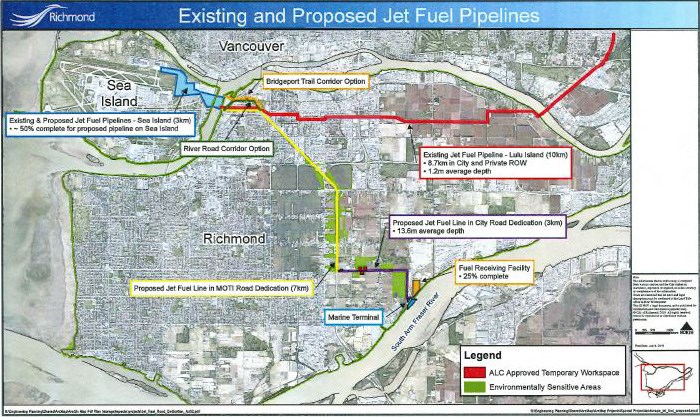Richmond city council appears to be granting the final piece of the puzzle that will allow a jet fuel pipeline to be built from the south arm of the Fraser River to the Vancouver International Airport.
At Monday’s committee meeting, council narrowly supported giving the Vancouver Airport Fuel Facilities Corporation (VAFFC) right-of-way access so it could build the pipeline to replace the current 52-year-old one that runs from a Burnaby refinery through north Richmond.
The majority of council also supported a servicing agreement for a marine off-loading terminal at 15040 Williams Rd. in south-east Richmond, which will have six giant fuel storage tanks.
VAFFC already had permission from the BC Oil and Gas Commission to build the pipeline, but they needed the go-ahead from the city to use its roads.
The longest part runs under Highway 99 and the province has granted permission for that already.
All federal and provincial regulatory approvals are in place to build the pipeline, including an environmental assessment from 2013.
Richmond-based, grassroots environmental protest group VAPOR — led by now city councillor Carol Day and former DFO biologist Otto Langer — battled the pipeline plan for years.
At this week’s committee meeting, Couns. Carol Day, Michael Wolfe, Kelly Greene and Harold Steves voted against the motions.
Day pointed out that, if the city didn’t approve it, it would go to the province for approval and she’d prefer the province wore the decision.
She added she was also not impressed with the $2 billion in insurance that VAFFC has to have in coverage, in the event of a spill.
“If you don’t have the infrastructure in place, it doesn’t matter how much insurance you have, you’re going to have jet fuel from one end of the Fraser to the other, which will kill the fish habitat and affect the Fraser River forever,” Day said.
She added she was “extremely unhappy” with the fire response plan, a foam fire suppression system that kicks in after a five-minute delay.
While the fire suppression system isn’t a “name brand” program, Coun. Alexa Loo said, “it’s quite clear, though, the VAFFC probably wants to protect its fuel, its infrastructure and its staff, and they’re putting in what they think is the best program.”
Staff said it was through their insistence the system was put in place.
The agreement brings benefits to the city including about $10 million and the ability to build a road on top of the right-of-way as part of the pipeline will be built on unopened road allowances.
Greene said she was grateful for the good insurance terms, however, while the $10 million benefit to the city sounded like a lot of money, it was over a period of 30 years.
“All the money in the world isn’t going to bring back the fish, it’s not going to bring back the ecosystem of the internationally recognized Fraser estuary,” Greene said. She added that this project “encourages and facilitates” increasing greenhouse gas emissions.
YVR gets 80 per cent of its fuel now from the current 40-kilometre pipeline, which runs from Burnaby through north Richmond, and 20 per cent from tanker truck deliveries. VAFFC has said the current pipeline is at maximum capacity and it needs 70 truck deliveries per day of fuel during peak times to keep up with demand.
When Coun. Chak Au asked whether the agreement could include something about renegotiating the terms if technology changed down the road, city staff noted that it is governed by federal and provincial legislation, so if there are changes to technology, there would be pressure to change the legislation to reflect that.
The city’s solicitor, Anthony Capuccinello Iraci, said there is an entire regulatory scheme in place to regulate oil and gas in B.C.
“The standards that they impose through regulation, those are constantly amended to improve public safety,” he said. “Those apply regardless of whatever agreement exists.”
Au said he was conflicted by the proposal before council, but it was probably the best deal the city could get.
“My left brain is fighting my right brain,” he said. In the end, he supported the staff recommendation.
The marine terminal servicing agreement includes trails in the area, 350 metres of new dikes, bank protection and off-site and on-site environmentally sensitive and riparian management areas.
At committee, council also approved a decision from the Agricultural Land Commission (ALC) to allow a worksite on the Agricultural Land Reserve, something that was agreed to by the ALC without the city’s knowledge, according to council documents.
VAFFC is a not-for-profit consortium, made up of 34 domestic and international commercial airlines.
A motion to use the $10 million for emergency preparedness and possibly a fire boat was supported.
The final decision will be made at a future council meeting.



